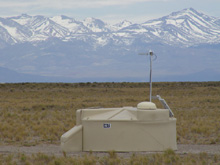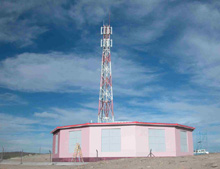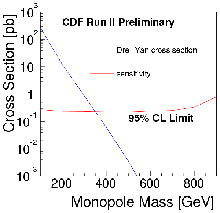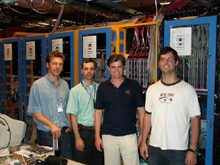 | Thursday, August 26, 2004 |
|
Thursday, August 26 2:30 p.m. Theoretical Physics Seminar - Curia II Speaker: A. Daleo, Fermilab/Universidad de la Plata Title: Fracture Functions and Higher Order QCD Corrections to Semi-Inclusive DIS 3:30 p.m. DIRECTOR'S COFFEE BREAK - 2nd Flr X-Over THERE WILL BE NO ACCELERATOR PHYSICS AND TECHNOLOGY SEMINAR TODAY
Friday, August 27 |
|
Thursday, August 26 Minnesota Wild Rice with Chicken Tuna Melt on Nine Grain $4.75 Breaded Veal with Mushroom Cream Sauce $3.75 Sweet & Sour Pork over Rice $3.75 BLT Ranch Wrap $4.75 Cheesey Breadsticks $1.85 Toasted Pecan Chicken Salad $4.75 Wilson Hall Cafe Menu Chez Leon |
|
Extended Forecast |
Secon Level 3 |
| Fermilab Today is online at: http://www.fnal.gov/today/ Send comments and suggestions to today@fnal.gov Fermilab Today archive Fermilab Today PDF Version Fermilab Result of the Week archive Fermilab Safety Tip of the Week archive Linear Collider News archive Fermilab Today classifieds Subscribe/Unsubscribe to |
|
From the Daily Herald, August 21, 2004 Student's perfect ACT score no surprise By Lisa Smith Learning she scored a perfect 36 on the ACT didn't surprise Hannah Newfield-Plunkett. After all, the St. Charles East High School honor student also earned a near-perfect 1580 on her SAT and achieved the highest score possible on her advanced placement calculus exam. "We're thrilled but it's just one in a series of successes, so in a way it didn't seem that unusual to us," said her mom, Mady Newfield. "We're utterly thrilled with who she is and what her hopes are." ...In addition to visiting Ivy League campuses, Newfield-Plunkett spent most of the summer working with her father at Fermilab. She served as a member of the famed "neutrino project" team with her father, Rob Plunkett, a physicist and deputy project manager for Neutrinos at the Main Injector, or NuMI.
The project aims to measure the masses involved in the transformation of
the subatomic particles.
|
|
CDF Searches for Magnetic Charge | ||
| ||
|
Haven't we all played with magnets, arranging them to attract or repel
each other? These forces are caused by the magnet's north and south
poles. Every magnet has two poles; if you break one, each piece still
has two poles.
In 1931, Dirac hypothesized a magnetic monopole, a single north or south pole by itself. We see electric monopoles all the time as negative electrons, but magnetic monopoles have not been discovered. Electricity and magnetism are closely interrelated. Magnetic monopoles would be accelerated by a magnetic field like electrons in an electric field. Monopoles would also be highly ionizing, so to find them, CDF triggers on large light pulses in Time-of-Flight scintillator bars. In the tracking detector, monopoles would cause high energy hits in a pattern resembling a high pT track. A team at CDF searched for magnetic monopoles in 25 pb-1 of data. While none were found, the team determined that monopoles cannot be produced with a cross section (rate) greater than 0.3 pb-1. Furthermore, if they are produced in pairs like electrons--the Drell-Yan mechanism--then monopoles must have a mass greater than 350 GeV. These are currently the world's best limits from a direct search for magnetic monopoles. | ||
| ||
|
Result of the Week Archive
|
|
Wilson Hall Power Outages - On August 28 and 29, Wilson Hall will have power but no air conditioning. - Power will be out September 13 for half an hour starting at approximately 7:00 a.m. - Power will be out September 24 for half an hour starting at approximately 7:00 a.m. For more information, contact Wilson Hall Building Manager Stan Boyson at x4753.
Booster, CUB, and Cross Gallery Power Outages
Scheduled Downtime for IMAPServer1
New Book Purchase Suggestion Lists
GSA Triathlon Saturday |



